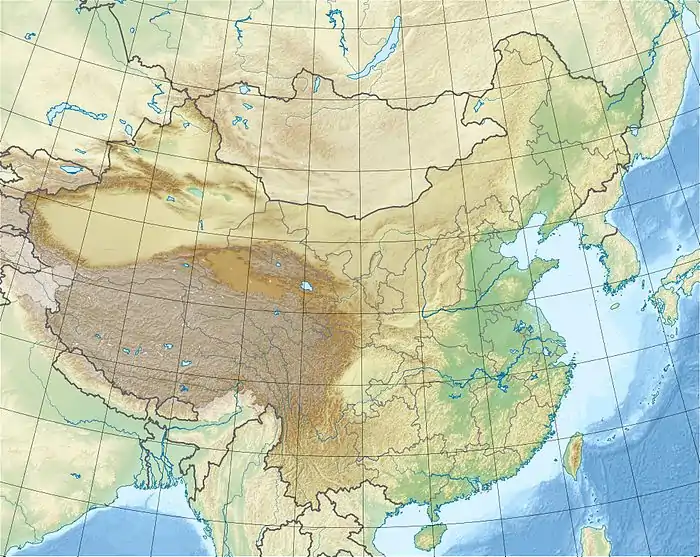Dapingian
The Dapingian is the third stage of the Ordovician and the first stage of the Middle Ordovician. It is preceded by the Floian and succeeded by the Darriwilian. The top of the Floian is defined as the first appearance of the conodont species Baltoniodus triangularis which happened about 470 million years ago. The Dapingian lasted for about 2.7 million years until about 467.3 million years ago.[6]
| Dapingian | |
|---|---|
| 470.0 ± 1.4 – 467.3 ± 1.1 Ma | |
| Chronology | |
Epochs in the Ordovician -485 — – -480 — – -475 — – -470 — – -465 — – -460 — – -455 — – -450 — – -445 — – Epochs of the Ordovician Period. Axis scale: millions of years ago. | |
| Etymology | |
| Name formality | Formal |
| Usage information | |
| Celestial body | Earth |
| Regional usage | Global (ICS) |
| Time scale(s) used | ICS Time Scale |
| Definition | |
| Chronological unit | Age |
| Stratigraphic unit | Stage |
| Time span formality | Formal |
| Lower boundary definition | FAD of the Conodont Baltoniodus triangularis |
| Lower boundary GSSP | Huanghuachang section, Huanghuachang, Yichang, China 30.8605°N 111.3740°E |
| GSSP ratified | 2007[4] |
| Upper boundary definition | FAD of the Graptolite Undulograptus austrodentatus |
| Upper boundary GSSP | Huangnitang Section, Huangnitang Village, Changshan, Zhejiang, China 28.8539°N 118.4897°E |
| GSSP ratified | 1987[5] |
Naming
The Dapingian is named after a village that lies nearby the Dapingian GSSP (Huanghuachang section, in Huanghuachang) where there is also an outcrop of similar rocks, the "Chenjiahe section" (formerly "Daping section") in Chenjiahe. The name was proposed in 2005.[7]
GSSP

The GSSP of the Dapingian is the Huanghuachang section (30.8605°N 111.3740°E), in Huanghuachang, Yichang, China. It is an outcrop of the Dawan Formation. The lower boundary is defined as the first appearance of the conodont species Baltoniodus triangularis in the type section. Radiometric dating has constrained the Floian-Dapingian boundary at 470 million years ago.[6] The exact boundary lies 10.57 m above the base of Dawan Formation.[7][8]
Palaeontology
Agnathans
| Agnathans of the Dapingian | ||||
|---|---|---|---|---|
| Taxa | Presence | Location | Description | Images |
| Dapingian-Sandbian | Sacabamba, Cochabamba Department, Bolivia; Horn Creek Siltstone, Australia; Argentina; Oman | |||
Endocerids
| Endocerids of the Dapingian | ||||
|---|---|---|---|---|
| Taxa | Presence | Location | Description | Images |
| Dapingian-Homerian | ||||
| Dapingian-Hirnantian | ||||
| Dapingian-Darriwilian | Chazy Reef Formation, New York, USA | |||
| Dapingian-Darriwilian | West Spring Creek, Oil Creek Limestone, Oklahoma | |||
| Dapingian-Darriwilian | ||||
| Tremadocian-Darriwilian | ||||
References
- Wellman, C.H.; Gray, J. (2000). "The microfossil record of early land plants". Phil. Trans. R. Soc. B. 355 (1398): 717–732. doi:10.1098/rstb.2000.0612. PMC 1692785. PMID 10905606.
- Korochantseva, Ekaterina; Trieloff, Mario; Lorenz, Cyrill; Buykin, Alexey; Ivanova, Marina; Schwarz, Winfried; Hopp, Jens; Jessberger, Elmar (2007). "L-chondrite asteroid breakup tied to Ordovician meteorite shower by multiple isochron 40 Ar- 39 Ar dating". Meteoritics & Planetary Science. 42 (1): 113–130. Bibcode:2007M&PS...42..113K. doi:10.1111/j.1945-5100.2007.tb00221.x.
- Lindskog, A.; Costa, M. M.; Rasmussen, C.M.Ø.; Connelly, J. N.; Eriksson, M. E. (2017-01-24). "Refined Ordovician timescale reveals no link between asteroid breakup and biodiversification". Nature Communications. 8: 14066. doi:10.1038/ncomms14066. ISSN 2041-1723. PMC 5286199. PMID 28117834.
It has been suggested that the Middle Ordovician meteorite bombardment played a crucial role in the Great Ordovician Biodiversification Event, but this study shows that the two phenomena were unrelated
- Chen, Xu; Bergström, Stig; Zhang, Yuan-Dong; Fan, Jun-Xuan (2009). "The base of the Middle Ordovician in China with special reference to the succession at Hengtang near Jiangshan, Zhejiang Province, southern China" (PDF). Lethaia. 42: 218–231. doi:10.1111/j.1502-3931.2008.00148.x. Retrieved 13 December 2020.
- Mitchell, C.; Xu, Chen; Yuan-dong, Zhang; ZhI-hao, Wang; Webby, B.; Finney, S. (September 1997). "Definition of a global boundary stratotype for the Darriwilian Stage of the Ordovician System". Episodes. 20 (3): 158–166. Retrieved 13 December 2020.
- "GSSP Table - Paleozoic Era". Geologic TimeScale Foundation. Retrieved 24 November 2012.Note: there is an apparent typo in the article referenced; they give the coordinates as "a latitude of 30°51’37.8"N and a longitude of 110°22’26.5"E", but their map and location description better corresponds to 30°51’37.8"N 111°22’26.5"E.
- Wang, Xiaofeng; Stouge, Svend; Erdtmann, Bernd-D.; Chen, Xiaohong; Li, Zhihong; Wang, Chuanshang; Zeng, Qingluan; Zhou, Zhiqiang; Chen, Huiming (2005). "A proposed GSSP for the base of the Middle Ordovician Series: the Huanghuachang section, Yichang, China" (PDF). Episodes. 28 (2): 105–117. Retrieved 4 June 2013.
- Wang, Xiaofeng; Stouge, Svend; Xiaohong, Chen; Zhihong, Li; Chuanshang, Wang; Finney, Stan C.; Qingluan, Zeng; Zhiqiang, Zhou; Huiming, Chen; Erdtmann, Bernd-D. (2009). "The Global Stratotype Section and Point for the base of the Middle Ordovician Series and the Third Stage (Dapingian)" (PDF). Episodes. 32 (2): 96–113. Retrieved 4 June 2013.
- Gradstein, F. M., ed. (2012). The Geologic Time Scale 2012. Elsevier Science Ltd. p. 504. ISBN 978-0444594259.
